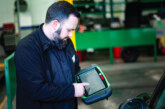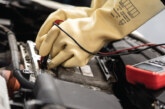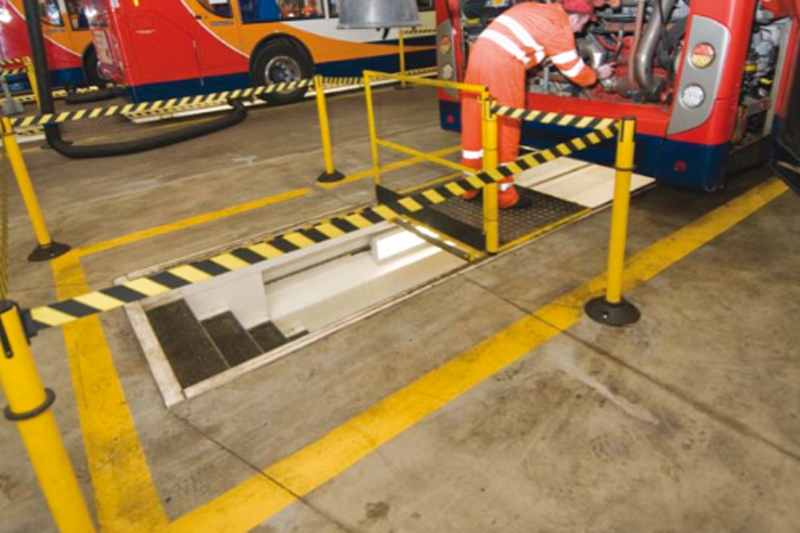
The HSE has published a leaflet with extracts from HSE inspectors’ accident reports (mostly fatalities) involving people working beneath vehicles in motor vehicle repair. They don’t cover every danger but do include explanations of how you can minimise the most serious risks.
Working beneath a vehicle is often required to check for faults, servicing, repairs etc. Unfortunately, serious and fatal accidents do happen each year despite the dangers and precautions being well known.
- Use the correct equipment
- Don’t be tempted to take short cuts or use inappropriate items.
- Never work beneath a vehicle that is only supported on jacks; use axle stands that are in good condition and inspected every year.
- Use equipment correctly
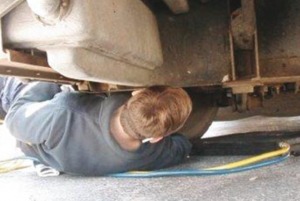
- Make sure there are safe working procedures in place when moving heavy loads, particularly when they are raised.
- Pins for axle stands need to be close-fitting and of the correct specification – screwdrivers, bolts etc. are not acceptable.
- For most axle stands you should use no more than a single pair.
- Use stands on a hard, level surface.
- Make sure that each stand is securely located under a strong point on the vehicle.
- Do not exceed the rated capacity of the stand.
- Make sure lifting equipment is installed correctly
- Make sure the floor and fixings meet the lift manufacturer’s specification.
- Once installed, the lift must be tested and certified before use by a competent person.
- Regularly check the fixing bolts with a torque wrench to ensure they remain tight.
- Maintain lifting equipment and train operators to use it correctly
- Vehicle lifts need to be kept in good order. Follow the manufacturer’s maintenance instructions and replace consumable items, such as lifting pads, before they become unsafe.
- Make sure employees evenly balance the lift for different types of vehicle (i.e. varying the position according to its centre of gravity and the lift type).
- For two-post lifts check:
- The arm locks show no signs of damage to their locking teeth and that they engage fully as the vehicle is lifted.
- The vehicle is secure by lifting to about a metre, confirming the lifting pads are positioned correctly, and then rocking the vehicle.
- Use proper pad extensions where required, not blocks of wood.
- Use props for additional vehicle support when removing heavy components.
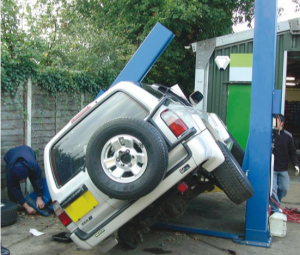
- Check equipment regularly and get it inspected
- Vehicle lifts need to be thoroughly examined periodically (ideally every six months) by a competent person, who should issue a ‘Report of Thorough Examination’. This is not a replacement for regular in-house checks and maintenance – in the same way that you shouldn’t rely on an MOT to keep your vehicle roadworthy.
- Get lifting equipment such as trolley and bottle jacks thoroughly examined every year and test and inspect props and axle stands.
- Take extra care when working away from the workshop
- Make sure the ground is firm and level before raising a vehicle.
- If the area is unsuitable, move the vehicle before attempting to lift it.
- Always prop cabs and tipping trailers
- Always prop cabs, trailers etc. that could drop under their own weight.
- If there is no prop fitted, or if one is fitted but you are unsure it will be effective, provide your own.
- Don’t work beneath a vehicle with air suspension unless you prop it first
- Don’t tamper with the ride height for the purpose of recovery
- Never crawl beneath a vehicle fitted with air suspension unless properly supported.
- Ensure everyone working on a vehicle knows the safe systems of work
- Where possible, the person working beneath the vehicle should remove and keep the ignition key.
- If the engine needs to be running, have a safe system of work to stop the vehicle moving (e.g. chock the wheels and ensure good communication between workers).
- Take care when working in or near pits
- Restrict access to the pit area to people who need to be there.
- Where practical, cover pit openings when they are not in use.
- Provide safe access across open pits.
- Use extendible barriers, chains etc. to warn about open pits.
- Make sure pits are clearly visible.
- Provide safe means of entry and exit.
- Don’t weld, work on air conditioning or leave engines running over pits unless there is effective extraction.



